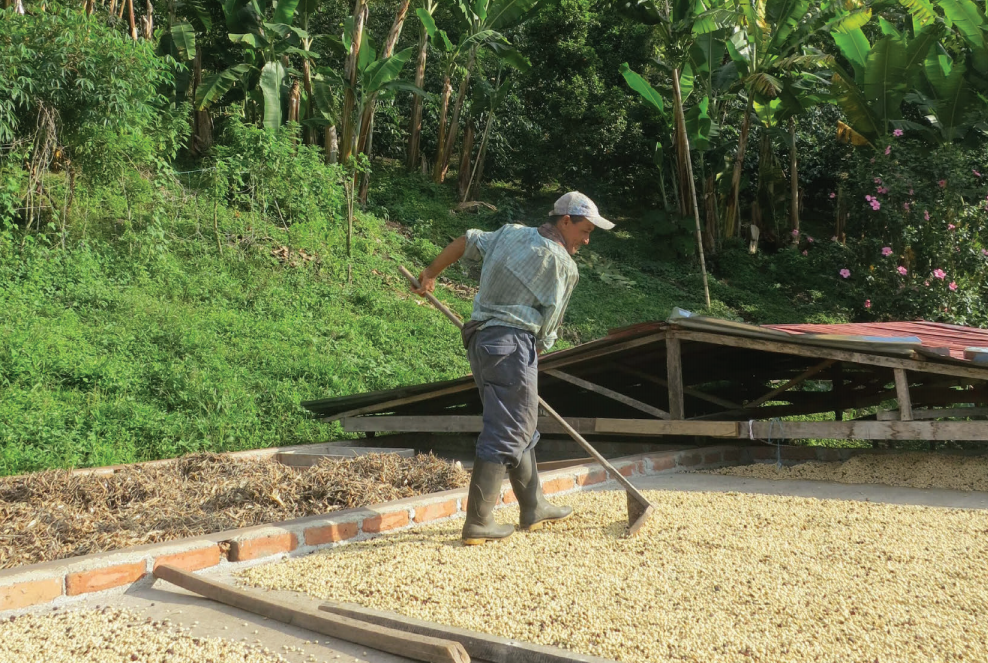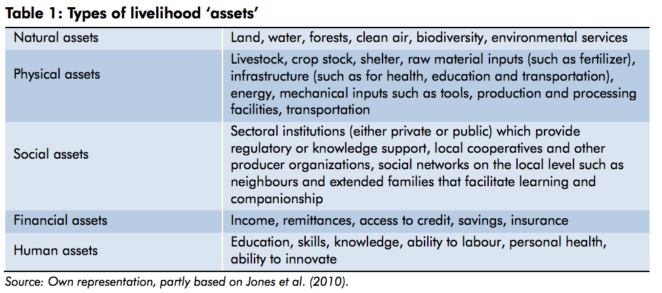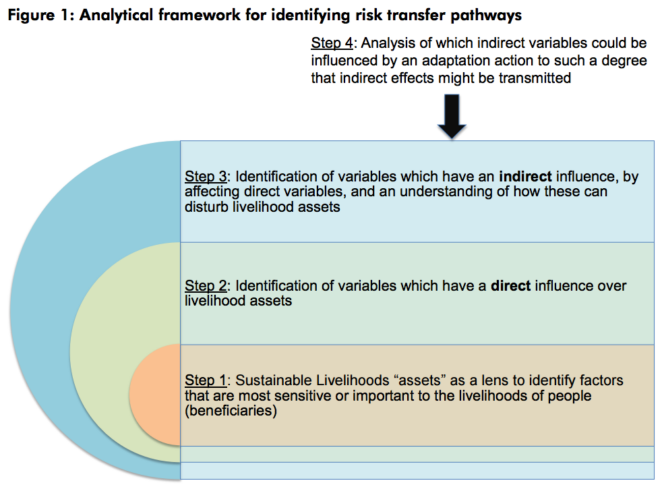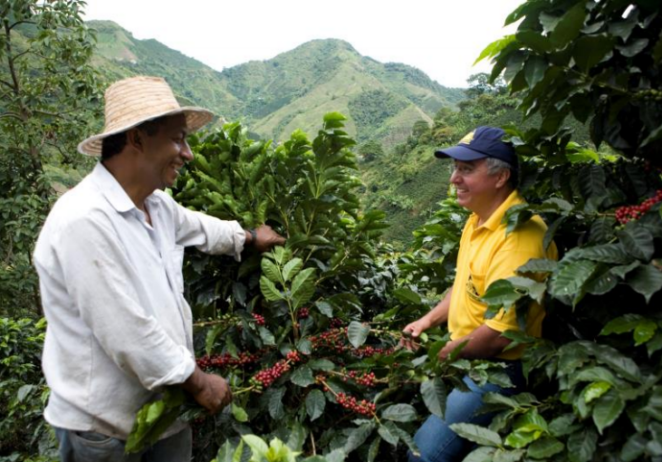The Indirect Effects of Adaptation: Pathways for Vulnerability Redistribution in the Colombian Coffee Sector

Introduction
This paper* examines the possibility that measures taken to bolster livelihoods and adapt to climate change in one place could increase vulnerability elsewhere. In a world characterized by increasingly complex economic, social and biophysical interconnections, vulnerability redistribution may in fact represent the norm rather than an exception. The authors examine the literature on globalization, development and adaptation to understand how adaptation interventions might create indirect effects that undermine the livelihoods of other people, and how we might predict and/or measure such indirect effects. They then propose a framework that practitioners could use to analyse planned adaptation interventions – specifically, those focused on strengthening livelihoods – in order to identify potential indirect impacts. They apply the framework to a case study of Colombia’s coffee sector, and find several examples of how, because of the connections between farmers in Colombia, and the global nature of the coffee market, adaptation actions within Colombia and abroad could redistribute vulnerability. Finally, they discuss how these insights might inform decisions by adaptation and development practitioners, and suggest areas for further research.
*download the paper from the right-hand column or via the link provided under further resources. The proposed framework and key concluding remarks (abridged) are given below. Please see the full text for details of the application of this framework (and the results) to the case of Colombia’s coffee sector.
A Framework for Assessing Indirect Effects
Finding robust metrics by which to assess vulnerability has proved a challenge (Adger 2006). Vulnerability itself is dynamic in nature (for an in-depth discussion, see IPCC 2012), and it is influenced by both social and material outcomes as well as by complex linkages between individuals and systems that can be difficult to “pin down”. Thus, it is difficult to precisely measure vulnerability even as a “snapshot in time”. Measuring the specific impact on someone’s vulnerability of an action by others far away – much less predicting such an impact – can be impossibly difficult, given the number of variables involved.
In the face of these challenges, we argue for an alternative approach: to identify in more general terms how the elements underpinning people’s livelihoods might be affected by the actions of others. By understanding the core elements of people’s livelihoods and what factors influence these, we can identify some of the pathways by which risk and vulnerability might be transferred between people and places (what we refer to throughout the remainder of the paper as “risk transfer pathways”). Though such an approach tells us nothing about actual outcomes in specific cases, it still offers a way to assess the possibility that a given intervention will produce indirect effects.
Towards this goal, we propose an analytical framework based on the following two-step logic:
- Any actual indirect effects triggered by an adaptation action will manifest for people elsewhere in terms of disturbances to their livelihood assets, since these form the basis of their capacities and opportunities to respond to their situation.
- We therefore need to understand how particular livelihood assets for a group of adaptation beneficiaries are connected to those of others, and how changes elsewhere might create or exacerbate vulnerability.
The elements of people’s livelihoods that may be disturbed by vulnerability redistribution are the various “assets” (or “capitals”) described in so-called livelihoods approaches to poverty and development. Emerging from development economics, and in particular from earlier entitlements analysis of poverty (Sen 1982), livelihoods approaches focus on specific characteristics of the resources with which people can construct a livelihood, and the way these resources are connected to those of others. Specifically, they draw attention to people’s ability to access different kinds of “assets”; Chambers and Conway (1992) identify five crucial asset types: natural, physical, social, financial and human (individual) assets. Examples of each are given in the table below. These assets underpin the livelihood strategies pursued by people, which typically consist of a range and combination of activities and choices, not just a single one, and may change as new opportunities or constraints arise (Chambers and Conway 1992).

Our framework, represented in Figure 1, directs practitioners to focus on the following questions:
- What are the main sources of vulnerability for the target group?
- How do these variables connect with other people, places and events? In other words, what factors affect these variables, directly and indirectly?
- What kind of adaptation or development interventions might disturb or influence one or more of these connections?
Figure 1 indicates the steps in utilizing this framework to evaluate the potential for adaptation to create indirect effects.

The livelihoods approach compels the analyst to look without prejudice across a range of potential variables that might be affected indirectly by action elsewhere, rather than emphasize one (such as household income levels) at the expense of others. To meaningfully generate the data needed to answer these questions, practitioners need to undertake place-specific analysis of how livelihoods are constructed and how these are connected to others through economic, social and biophysical linkages. As Bebbington (1999) argues:
“The principal assets that people draw upon in building their livelihoods… vary across space and also across different social, gender and ethnic groups. If this is so, it becomes important to have a clearer sense of the most important assets for different people in different places in order to identify the most useful (and most damaging) sorts of public investment in such areas.” (p.2031f)
One challenge for adaptation practitioners is that while the intended beneficiaries of adaptation actions are known in advance, those who may experience indirect effects are not. Thus, the analyst is left to trace interconnections outwards from beneficiaries and make assumptions about how changes here might be experienced there.
Concluding remarks (abridged)
To further our understanding of indirect effects of adaptation and be able to meaningfully incorporate it into adaptation practice, more empirical analysis of actual indirect effects is needed, from a wide range of examples. Such research could help us to better understand complexity and what that might mean when complex systems are affected by, for instance, adaptation actions.
The framework we propose is one approach, but there are also other tools available for studying behaviour and response in complex systems. Agent-based modelling, for instance, is essentially aimed at modelling behavioural responses under specific scenarios (e.g. a development or adaptation intervention) in order to reveal possible system-level outcomes that might not be predicted using “common sense”. Neither approach offers robust probabilistic outcomes. One strength of taking our approach is that it could help practitioners identify some potential indirect effects that are not immediately obvious, and also help overcome some of the limitations of modelling approaches, which usually require intensive data inputs (i.e. a reasonable understanding of variables in the system and how they interact) and yet are still gross simplifications of reality. The framework we propose here could, in fact, provide useful input to such modelling exercises, by identifying in the first instance the kinds of interactions that might be important to understand and model.
We also need to highlight a number of limitations of our framework, especially since our hope is to inspire further work on this topic and to improve the way we deal with the concept of indirect effects:
- It is incomplete. For example, the choice of a framework based on livelihoods approaches means the approach focuses on the vulnerability and adaptive capacity of particular individuals or groups of people. Practitioners may also want to consider how ecosystems might be indirectly affected; the identification of risk transfer pathways might have some value in helping the analyst identify likely environmental impacts, even if they cannot predict all ecosystem effects.
- Using livelihood assets as a point of departure tends to focus the analyst on identifying variables that are important at the individual or household level, which won’t necessarily identify risks transferred to other scales. As Adger (2006) has pointed out, it is also important to consider vulnerability at the whole-system level, where the influence of governance and institutions, for instance, is more relevant than it might be at the individual or household level.
- Third, a focus on pathways by which impacts might be transmitted says nothing about actual outcomes (indirect effects) on the ground. Individual risk/vulnerability outcomes are almost impossible to trace in a direct cause-and-effect way, given the number of global linkages that must be chased through in any specific example. For practical reasons, therefore, such analyses rely on using proxies of indirect effects – in this case, risk transfer pathways – and these identified from the perspective of the adaptation beneficiary rather than those who might experience indirect effects. Ultimately, even if we identify pertinent pathways for transfer of vulnerability, it is another matter altogether to assess eventual livelihood outcomes for specific individuals or groups, since people have different capacities to cope with, or adapt to, changes in their access to livelihoods.
- We do not address the next important question for practitioners: how to make tradeoffs once an awareness of potential indirect effects has been created. What a practitioner does with this awareness involves normative judgments about the best course of action, assessing or weighing the known (likely) benefits for one target group against the possible (and lesserknown) indirect outcomes for others. What we know from psychology research is that people diminish the value of negative outcomes that are distant in place or time (Markowitz and Shariff 2012), so meaningfully addressing indirect effects remains not only a technical challenge related to identification and measurement, but also a cognitive and ethical one.

Suggested Citation
Atteridge, A. and Remling, E. (2013) The indirect effects of adaptation: Pathways for vulnerability redistribution in the Colombian coffee sector. SEI Working Paper No. 2013-10. Stockholm.
(0) Comments
There is no content